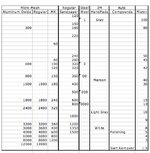Larry in Harrow
Member
I find most charts of this type too complex to be useful. After a thread on Penturner's Paradise I compiled a chart for all the abrasives I use to sand and finish pen barrels. The data was gleaned from several charts available on the web and from this forum. If there are any errors please let me know and I'll correct the PDF file. However most of the data agrees with my experiences. I did find that I was overlapping (even going backwards a little) when I was switching from wet/dry to MM papers so the exercise saved me a few steps. Most interesting is where the Beall compounds fit into the overall scheme. Hope you find this useful.
View attachment Abrasive-Grits.pdf
View attachment Abrasive-Grits.pdf
Last edited:

